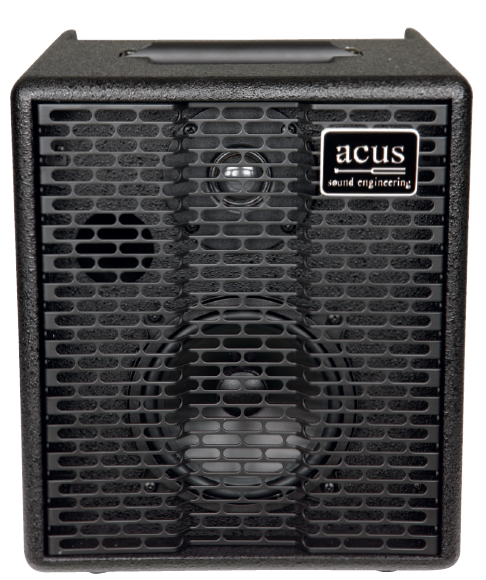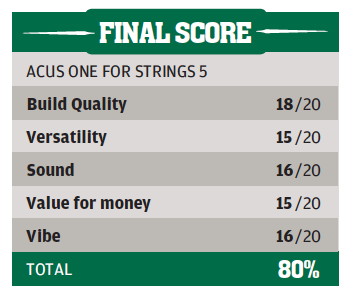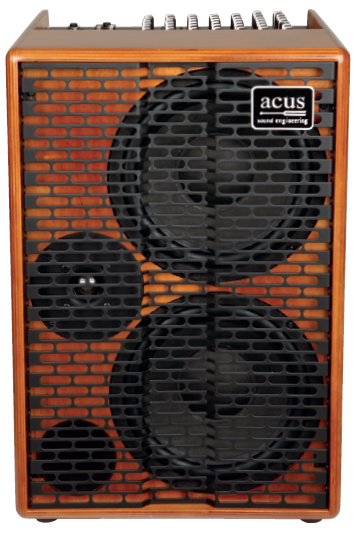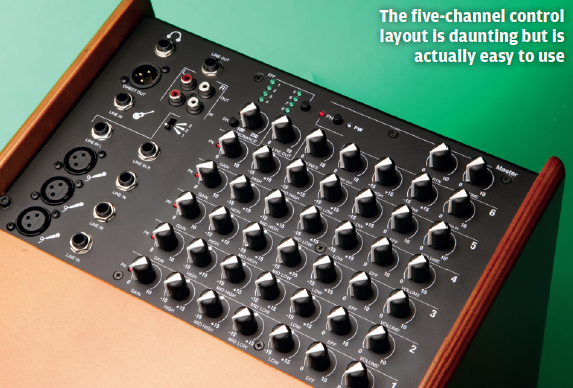Related Tags
ACUS One For Strings 5 & 10 Acoustic Amplifiers
From a simple acoustic guitar amp to a virtual PA-in-a-box, Italy’s Acus is a sound reinforcement company to watch.

One For Strings 5:
Specs: 50W solid state acoustic guitar amplifier with microphone and line level inputs, Aux In, Direct Out and built in reverb effect. Made in Italy
Price: £469
One For Strings 10:
Specs: 350W solid state acoustic guitar amplifier with three mic/line channels and two line level instrument channels; eight reverb FX; headphone, line and direct outputs; phantom power switching, stereo line input and output, sweepable notch filter. Made in Italy
Price: £469
Contact: Freestyle Music Ltd, 01924 455414 , www.acus-sound.it
Acus is a small family owned company that was established two years ago. Frederico Canale, the man behind Acus, has over 40 years of experience in audio electronics and started out making amps for Eko back in the 1960s. More recently, he headed up R&D as a co-owner of Schertler.
Acus amps are made and assembled by local craftspeople in and around Recanati in Italy, and the attention to detail is apparent. The varnished plywood cabinet of the Acus 10 really caught our eye, along with the bent metal speaker grilles, smart badges and simple but robust metal carrying handles.

You can choose between varnished ply or black tolex cabinets, and they cost exactly the same. Although there are no corner protectors, slip covers are available.
The company’s mission is to ‘produce a sound design that amplifies acoustic sound with clarity, purity and natural tone’. When they say ‘acoustic sound’ it’s not just acoustic guitars. These amps are also intended for violins, cellos, mandolins and more. The cabinets are loaded with multiple drivers and they’re bi-amplified like active studio monitors to achieve a wide frequency response with a low slew-rate.
The designers employ Class A stages in strategic positions of the preamplifiers to simulate the warmer tones of high-end valve amplifiers. Cabinets are built in the Acus custom shop and the loudspeakers are manufactured to Acus’ specification with ultra-light responsive cones.
Viewed front on, both these amps really do look more like active studio monitors or expensive PA speakers than regular electro-acoustic amps. Then again, besides a shared design aesthetic, these amps are quite different from one another.
The Acus 5 is a tiny, fairly straightforward acoustic guitar amp with an additional mic input, while the ACUS 10 is virtually a complete condensed PA system.
Acus One For Strings 5
Besides the ground lift and power switches on the back panel, all the controls and connections are mounted on the top panel. First up is the XLR microphone input, with an input impedance of 1K ohms; this should interface quite nicely with any low impedance dynamic microphone with a balanced output.
Next up is a jack socket for line input. With an input impedance of 470K ohms it’s optimised for high output instrument, so you’ll need an electro-acoustic with an onboard preamp to use the ACUS 5, or you could plug an external preamp between a passive pickup and the Acus 5. Unfortunately you can’t connect a microphone and instrument simultaneously because plugging into the line input defeats the mic input.
Labelled Normal and Hi Sens, the sensitivity switch helps the Acus 5 to interface with a variety of different input sources. Equalisation controls provide plus and minus 15dB adjustment in the High, Mid and Low frequencies, but there’s no centre detent. You can probably guess what the Volume control does, and the Volume EFF blends the on board reverb effect into the dry signal.
An auxiliary audio source can be connected via the 3.5mm mini jack socket, and it also has a dedicated volume control. Lastly there’s a balanced line out jack socket to allow you to connect the Acus 5 to a PA system or to a second amplifier.
Sounds
Acus have concentrated on sonic quality rather than superfluous features. The 5 does have a very slight colouration in the midrange that we weren’t quite able to remove with the EQ controls. In a sense it’s comparable to the way that restricted speaker enclosure size can colour small electric guitar amps.
Other than that, it’s impressive stuff. The tone is crisp and clear with no discernible distortion and ample low end response. Although you’re restricted to just one reverb, it’s voiced well for acoustic guitar, adding a 3-D quality without swamping definition. Transient response is fast and natural, and we were able to dial up pleasing electro-acoustic tones very quickly. It’s also surprisingly loud, so pub gigs are well within the Acus 5’s capabilities.
Acus One For Strings 10
The One For Strings 10 is the largest Acus, and it’s designed as ‘an all-in-one five-channel solution for small ensembles as well as solo performers’. It’s a scaled-up version of the Acus 5, with three drive units and a maximum power output of 350W . It measures 47cm x 32cm x 35cm and at 14.5kg it’s a reasonably comfy one-handed lift
The first three channels have XLRs for mics plus line level input jacks. Channel 4 has two line level inputs labelled L and R plus a three-way switch that configures the response for viola and cello, acoustic guitar and semi-acoustic guitar. The last channel is a dedicated acoustic guitar channel.
All five channels share the same layout. From let to right there’s Gain (with overload light), High, Mid High, Mid Low, Low, EFF and Volume. EFF refers to the effects, which appear to comprise eight shades of reverb. Above the input channels there’s a section that loosely corresponds to the centre channel on a typical mixer, with master volume, headphone level, EFF return level and global phantom power switching for condenser microphones.
RCA/Phono sockets are provided for stereo line input and output along with High and Low EQ controls and Stereo In and Stereo Out level controls. Output signals can also be taken from the Line Out jack (unbalanced) and Direct Out XLR (balanced). Lastly, the Resonance control, when activated, applied a 12dB notch filter that can be swept from 100Hz to 250Hz to minimise low-mid frequency feedback.

Sounds
The family resemblance is clear, with the same clear, distortion-free tone and lightning-fast response, but this time the midrange colouration is completely absent. Splitting the midrange control over two frequency bands is extremely effective and, like the Bass and Treble controls, they achieve a lot without sounding at all processed.
Like the Acus 5 the basic sound is encouraging and simple fine-tuning will optimise the response for your pickup system. Rather than being artificially extended, the treble response is sweet and very much in line with the natural tone of an acoustic guitar.
Regardless of the pickup systems we used, we couldn’t provoke a response from the overload lights, but we did notice some extra brightness when running the Acus 10 with Gain high and Volume low rather than vice versa.
The effects turn out to be eight reverb programs with various decay times and tonal flavours. A bit more variety in reverb tone, in particular the amount of treble content, would have made this aspect even better.
Verdict
These are classy, well-made amplifiers that offer impressive sound quality and useful features. If the Acus 5 seems a bit basic and the Acus 10 is too complex for your needs, then do check out the other Acus products, because there are models in between.
